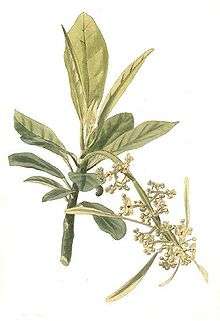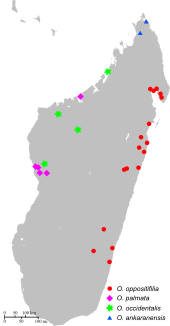Omphalea
Omphalea is a plant genus of the family Euphorbiaceae first described as a genus in 1759.[3][4] It is native to tropical parts of the Americas, the West Indies, Asia, Australia, and Africa (including Madagascar).[2][5][6]
| Omphalea | |
|---|---|
 | |
| Omphalea triandra[1] | |
| Scientific classification | |
| Kingdom: | Plantae |
| Clade: | Tracheophytes |
| Clade: | Angiosperms |
| Clade: | Eudicots |
| Clade: | Rosids |
| Order: | Malpighiales |
| Family: | Euphorbiaceae |
| Subfamily: | Acalyphoideae |
| Tribe: | Omphaleae |
| Genus: | Omphalea L. |
| Synonyms[2] | |
| |

Omphalea has monoecious, apetalous flowers and fleshy fruits with hard centers.[7]
Ecology
The plants are toxic and few animals can eat them. Diurnal moths of the subfamily Uraniinae feed on them. These moths are species of the genus Urania in the Americas, and of the genus Chrysiridia in Africa.
The only species from mainland Africa is from Tanzania is O. mansfeldiana, a liana from Tanzania . The Madagascan species are O. ankaranensis, a shrub from the limestone karst of northern Madagascar, O. palmata Leandri, a dry forest shrub closely related to O. ankaranensis but from western Madagascar, O. occidentalis Leandri, also a dry forest species of western Madagascar, and O. oppositifilia (Willdenow), a tree from the east coast rainforest of Madagascar.[7]
The Madagascan sunset moth (Chrysiridia rhipheus) feeds on all four of these species.
- Species[2]
- Omphalea ankaranensis - N Madagascar
- Omphalea bracteata - Indochina, Malaysia, Borneo, Philippines
- Omphalea brasiliensis - Bahia
- Omphalea celata - Queensland
- Omphalea commutata - Haiti incl Gonâve Island
- Omphalea diandra - Central + South America, West Indies
- Omphalea ekmanii - Dominican Rep
- Omphalea grandifolia - Philippines
- Omphalea hypoleuca - W Cuba
- Omphalea malayana - Pulao Tioman, Sarawak, Luzon
- Omphalea mansfeldiana - Tanzania
- Omphalea megacarpa - Grenada, Trinidad, Tobago
- Omphalea occidentalis - W Madagascar
- Omphalea oleifera - Mexico, Central America
- Omphalea oppositifolia - E Madagascar
- Omphalea palmata - WC Madagascar
- Omphalea papuana - Queensland, Papuasia
- Omphalea queenslandiae - Queensland
- Omphalea sargentii - Indonesia, Malaysia, Philippines
- Omphalea triandra - Jamaica, Haiti
- Omphalea trichotoma - Cuba
- formerly included
moved to other genera (Mabea Phyllanthus Sapium Sebastiania Senefeldera )
- O. axillaris - Phyllanthus axillaris
- O. cauliflora - Phyllanthus cauliflorus
- O. eglandulata - Sebastiania eglandulata
- O. epistylium - Phyllanthus axillaris
- O. glandulata - Sapium glandulosum
- O. lactescens - Mabea piriri
- O. verticillata - Senefeldera verticillata
References
- 1821 illustration from The botanical cabinet, consisting of coloured delineations of plants from all countries by Conrad Loddiges. London, C. Loddiges & Sons, etc., 1821, volume 6 (plate 519).
- Kew World Checklist of Selected Plant Families
- Linnaeus, Carl von. 1759. Systema Naturae, Editio Decima 2: 1254, 1264, 1378 in Latin
- Tropicos
- Govaerts, R., Frodin, D.G. & Radcliffe-Smith, A. (2000). World Checklist and Bibliography of Euphorbiaceae (and Pandaceae) 1-4: 1-1622. The Board of Trustees of the Royal Botanic Gardens, Kew.
- Schatz, George E. "Euphorbiaceae - Omphalea oppositifolia". MBG Images of Euphorbiaceae in Madagascar. Missouri Botanical Garden. Retrieved 2008-02-02.
- Gillespie, Lynn J. (1997). "Omphalea (Euphorbiaceae) in Madagascar: A New Species and a New Combination". Novon. 7 (2): 127–136. doi:10.2307/3392184. JSTOR 3392184.